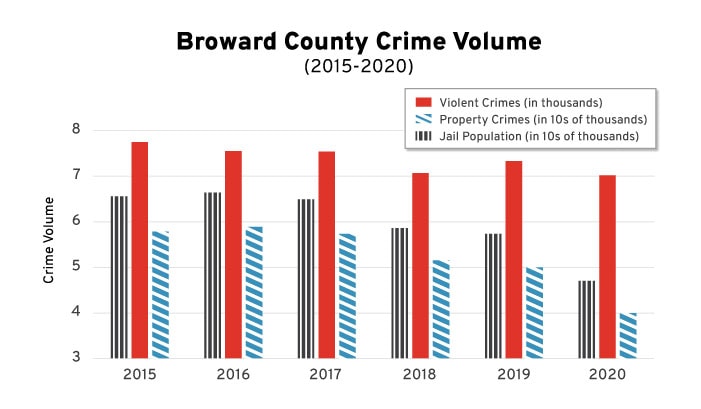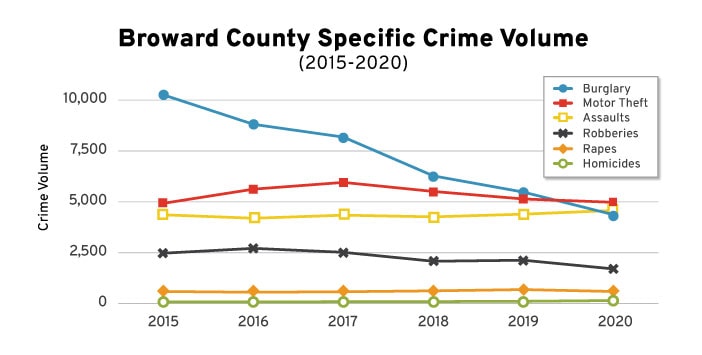Criminal Justice Reform Efforts and Rise in Crime: Spotlight on Broward County, Fla.
This is the first in a series of posts on the subject. Scroll to the end to see the most recent posts in the series.
Introduction
The nation has been captivated by reports of rising crime and the wave of criminal justice reform. Some news outlets and elected officials claim a correlation between the two, but this is perhaps a hasty assessment. In order to better understand how criminal justice reform efforts could be affecting increases in crime, we will be digging into the data, history and current criminal justice reform efforts of six Safety and Justice Challenge sites across the United States. Readers can learn about unique criminal justice reform initiatives in these communities as well as whether the implementation of these efforts (or lack thereof) could be associated with an increase or decrease in crime. To learn more about this series, you can access the introduction here.
Location Information
Broward County—where Fort Lauderdale lies—is home to beautiful beaches, a thriving tourist industry and a racially and culturally diverse population of almost two million people. There are 32 law enforcement agencies in Broward County covering 1,210 square miles.
Crime Statistics
Between 2015 and 2020, Broward County has seen an overall decrease in crime. Likewise, Broward County has seen a significant decrease in jail population during the same period. The graph below, compiled from data from the Florida Department of Law Enforcement, shows that both total property crime and total violent crime decreased over the same time period that jail populations decreased.

Following national trends, Broward County saw a slight increase in homicides and aggravated assaults from 2019–2020, but saw a decrease in most other crimes during that same time. A deeper examination in the graph below, using data from the Florida Department of Law Enforcement, shows that from 2015-2020 there was a substantial decrease in burglaries and a noticeable decrease in robberies, while other crimes saw less significant changes. Notably, however, Broward County saw a decrease in motor vehicle thefts, contrary to national trends.

Criminal Justice Reform Efforts
Broward County has implemented many different criminal justice reform initiatives over the years including initiatives such as Homeless Outreach Team, prosecutorial diversion and a new 9-8-8 system for mental health calls. Focusing on criminal justice reform efforts that appear to most substantially reduce jail populations, three initiatives within Broward County are highlighted herein: the mental health court, civil citations and a new bond schedule.
Mental Health Court:
Broward County is not a newcomer to innovative criminal justice initiatives: in 1997, the county launched the first mental health court in the nation for misdemeanor defendants; and 2003 saw the establishment of the mental health court for felony defendants. While drug courts have become fairly commonplace—Broward established theirs in 1991—mental health courts are rarer. This is despite research showing approximately two out of five incarcerated people suffer from mental health illnesses. Broward County’s mental health courts are special divisions of the criminal courts that handle cases involving defendants identified as mentally ill or developmentally disabled. Broward County established the mental health courts in response to concerns of overcrowded jails, jail suicides and a shortage of mental health services, among other community mental health shortfalls. The misdemeanor mental health court is a voluntary program that diverts non-violent offenders into treatment. The court aims to promote mental health wellness and recovery while decriminalizing mental health illnesses. The felony mental health court focuses on restoring defendants—of all crimes—back to competency and providing wraparound services for their continued success. Research shows that mental health courts reduce recidivism, save money and restore respect and dignity back into people’s lives.
Civil Citation:
In 2018, Broward County approved an ordinance for the use of adult civil citations for specific criminal offenses. Broward County has used civil citations for juveniles since 2014, but expanded civil citations to adults after they found the use of juvenile civil citations saved the county $14 million dollars over four years. Civil citation allows police officers to issue a civil citation in lieu of arrest or summons to court for low-level, non-violent offenses. The individual civilly cited may pay a fee, complete community service, or attend treatment or applicable programming rather than enter the criminal justice system. Failure to comply means the individual is subject to arrest and prosecution. Research shows that citation programs can save both law enforcement time and millions of taxpayer dollars. Further, participating individuals can avoid the collateral consequences of a criminal record that often result in loss of jobs and housing, thereby reducing the chance of recidivism.
New Bond Schedule:
On Feb. 24, 2022, the Chief Judge of the 17th Judicial Circuit issued an administrative order amending the bond schedule for Broward County effective April 4, 2022. This new bond schedule expands the number of offenses that qualify for release on recognizance. Now, individuals accused of class three felonies and lower offenses that are not violent or “involve the public welfare” are presumed to be released on their own recognizance. Research shows that pretrial detention increases the likelihood of housing insecurity, job loss and recidivism. Likewise, a new study shows that pretrial detention for any amount of time can be detrimental to public safety.
These criminal justice reform efforts work to divert low-level offenses, decriminalize behavioral health issues and free up valuable resources. This means that law enforcement officers have more time to investigate violent and serious offenses and to work proactively on crime reduction. Diverting individuals from the criminal justice system also helps unclog the courts, reduce the inmate population in overcrowded jails and save taxpayer dollars.
Conclusion
Based on the collected data, we conclude that reform initiatives in Broward County reveal no correlation with increased crime. While Broward County’s increase in homicides and aggravated assaults in 2020 is concerning, these trends seem to adhere to the national pattern, and do not seem to be correlated with Broward County’s specific reform initiatives. The overall reduction in crime over the past five years does seem to mimic the timing and implementation of civil citations in the county. However, this could also be part of a longer trend of declining crime rates. Some of Broward County’s reform efforts (such as the new bond schedule and the new 9-8-8 program) are in their infancy, so their impacts—whether positive or negative—are currently unknown.
This post will be updated with links to each part in the series.
- Criminal Justice Reform Efforts and Rise in Crime: Introduction
- Criminal Justice Reform Efforts and Rise in Crime: Spotlight on Broward County, Fla.
- Criminal Justice Reform Efforts and Rise in Crime: Spotlight on Clark County, Nev.
- Criminal Justice Reform Efforts and Rise in Crime: Spotlight on City of St. Louis, Mo.
- Criminal Justice Reform Efforts and Rise in Crime: Spotlight on Allegheny County, Pa.
- Criminal Justice Reform Efforts and Rise in Crime: Spotlight on Baton Rouge, La.
- Criminal Justice Reform Efforts and Rise in Crime: Spotlight on Missoula, Mont.
- Criminal Justice Reform Efforts and Rise in Crime: Conclusion









